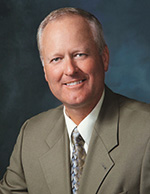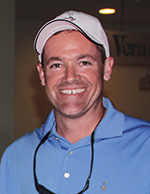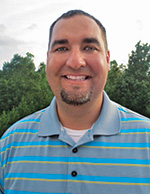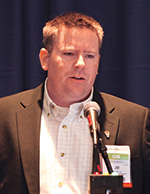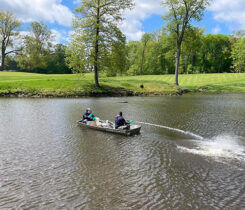Plant Health Part 1 of 3: What the buzzword means to golf course superintendents
Maximizing turf’s ability to handle and recover from stress quickly takes a lot of the basics, as well as some help from Plant Health products
The human body is comprised of many components that, when working in unison, perform perfectly to keep us moving forward with our daily lives. The body can be pushed to extremes. Put to the test like a machine primed for success. However this does not happen without proper maintenance.
Maintaining the human body runs parallel to maintaining turf. Both are living organisms. Both need to be nourished. Both need to be cared for in order to thrive. And at times, both need a little external chemistry to help boost their systems. This external chemistry for turf is now becoming commonly known as Plant Health.
“Well, hopefully we don’t have to use a lot of chemicals,” chuckles Jeff Holmes, superintendent at Egypt Valley CC, Grand Rapids Mich. “A good scenario would be if you’re eating good meals and getting some reasonable exercise, then you don’t have to be on a lot of vitamins and extra additives. We’re trying to do the same thing with the grass plant. We’re trying to minimize our inputs.”
To Holmes, who has been the head superintendent at Egypt Valley since 1993, Plant Health is not just a buzzword or a sticker on a label. “It’s not one item, it’s a whole package,” he says.
Defining Plant Health
Plant Health can be an elusive concept, leading to the question: What exactly is Plant Health?
“If you were to define Plant Health, it’s golf course putting greens, fairways or rough growing at optimum conditions,” says Brian Thompson, a former superintendent and now strategic account manager for BASF. “Anytime the plant is producing new leaves quicker than it is losing, you’ve got healthy turf. When you equate not just the visual aesthetics of turf, but also the playability of turf, which is greens speed, resiliency to stress… that’s how we in the turf industry define total turf health.”
In agriculture, another major market for Plant Health labels, success can be measured by yield. But how do you gauge the success of a Plant Health program when working in the golf industry? There is no traditional yield.
Thompson suggests looking elsewhere for results. “Yield can be measured in our golf industry as happy customers, happy members, good playing conditions and sustainable turf growth,” he says.
Time has a tendency to advance our technology and the same is true for the products used in the industry. “I think superintendents have long been extremely perceptive on some of the additional benefits these products may bring, in terms of performance… (they) are diligent at examining the performance of the product that they use in their programs,” Thompson says. “This adoption into embracing Plant Health, to achieve better playing conditions and better sustainable turf stands for today’s demands, I think has been really recognized in the last five to 10 years.”
Thompson says that BASF has been on a multiple year journey to reach their current understanding of Plant Health. Apart from identifying ways to measure success, they have seen an enhanced ability for the plant to recover after stress and an enhanced growing efficacy. This leads to a more robust, deeper and stronger root system. “That’s really where we’ve accumulated a lot of these success stories and showing that these products are helping build a stronger plant,” says Thompson.
A synergistic effect
Tommy Hewitt, superintendent at Windermere Golf Club in Flowery Branch, Ga., says his course is 100-percent on board with the Plant Health approach.
“Plant Health is something where you are getting a plant response, a positive plant response, by spraying something that you typically should not see a positive plant response from… (it’s) a much healthier plant due to some type of synergistic effects of that product,” Hewitt says. In the true sense of an ecosystem, each segment that has a positive response spreads those benefits to another segment.
Hewitt’s course uses BASF Plant Health products, especially on their greens where Mother Nature can be cruelest. Hewitt’s club is one within a company with 50 courses across the nation. The clubs range from Washington State to California, as far south as Florida and east to Virginia. “(Honor) is the staple of our program based on what we’ve seen. With the new products coming out, Lexicon, we can’t wait to see it in action,” says Hewitt.
Holmes also sees the benefits of Plant Health products as a whole when looking at his turf.
“There’s not one silver bullet that just corrects it all,” Holmes says. “You need to look under the carpet instead of just at the carpet. When you look underneath, you can learn a lot of things with your soil, your root structure and know how the rest of your plant is going to perform for the rest of the year.”
Like almost everything in life, you have to build a foundation and then fortify it as you go.
“Starting out with a good root system is critical. Density of the turf is the other big issue, then wear tolerance, or durability, are probably the key components we start looking at,” says Holmes.
Once the foundation is established, he says, no one thing will strengthen, maintain or decline the turf.
“It takes many parts to make it all work and the chemical part of it is only one element that we look at and try to use and manage,” Holmes says. “One product doesn’t take care of all the diseases that we deal with. We have to use different ones, different chemistries effect different pathogens. That’s why (chemical companies) make several different products for us.”
Holmes has seen the effects of Plant Health products on his course. The benefits included handling drought conditions better, improved hardiness and a quicker recovery time when a plant is on the mend from a disease. While it’s hard for him to explain, he won’t complain about the results.
“They can’t exactly put their finger on it, but when we’re using these products, it is making the plants healthier,” he says.
Bringing back the marathon analogy, Holmes says its like he’s suddenly seeing faster times.
“We were eating right and hydrating correctly and all of the sudden, it’s like we’ve picked our running speed up, we’re performing better than we ever have and we’re doing the same thing we’ve been doing for 10 years,” he says. “This years it’s working better.”
One-fifth of a plan
Jim Kerns, Ph.D., North Carolina State University, has kept a keen eye on Plant Health products. He says the concept itself isn’t new, and describes it simply as ‘giving the plant what it needs.’
“It’s of utmost importance that the idea of managing a turfgrass plant is you have to maximize the health of the plant in order for it to sustain the stress that it’s put under by a superintendent because of the demands of a golf course,” says Kerns. “I tell superintendents all the time, light, air, food and water. Those are the four simple elements of Plant Health and part of the components that we add on is protection.”
Similar to checking the box for additional collision coverage for car insurance, the protection component is a helpful add-on. Protecting turf from diseases can be necessary when considering the stress the plants are put under.
“That’s what I don’t think is a valid approach to managing turfgrass, the idea for a fungicide is inevitably, because (with) the stress we put turf plants under, we’re going to get a disease. Or if we don’t prevent it, the disease will develop. So a fungicide in many cases, becomes a necessary component in sustaining Plant Health because we control a disease,” says Kerns.
Despite being a proponent of Plant Health as a way to maintain turf, Kerns has his doubts on the topic.
“I’m kind of on the fence. I do believe in the term plant health and I use that as a framework to discuss disease management and the components of disease management,” he says. “The only thing I get frustrated with is that some cases, some of these products are marketed to say they do all these great things, when in many cases, when you look at the research and the data, the Plant Health effect is very transient.”
Kerns explained that no one thing accomplishes everything all at once. If a user is spraying only one component of a Plant Health product, the plants aren’t going to be healthy.
“It does occur, we do see some benefit to (Plant Health products), but it’s not like it’s a substitute for all the other practices that a turf manager is doing,” says Kerns. “It’s a culmination of multiple things coming together to make a plant healthy, not just products, that’s a component, but I see many very good products fail if the basics aren’t covered.”
For example, cultural practices such as aerification, topdressing, fertilization and precision water management all must be properly managed in order for turf to thrive.
“I do think a lot of these fungicides are one-fifth of that component. A very small fraction, but you bring all of that together and all of the sudden, we’re looking like we saw this (year) at Augusta National. When you bring everything together, then it maximizes the health of that plant and we can maximize the effectiveness of these pesticides that we use and cultural practices.”
Making plants healthier
As Plant Health bounces around the golf industry, the current buzzword on everyone’s tongue, it remains a vaguely explained concept.
“This Plant Health concept is very nebulous and I think that’s intentional. Because it has been driven as a buzzword, what I’ve been telling people is that it’s something that has existed for a very long time. It’s just now we have a term associated with it and a term that’s on labels,” says Kerns.
Buzzword or no, the practice behind Plant Health is one that both Hewitt and Holmes see playing a part in future turf management.
“I think with regulations coming… we’re going to have to look at things that are going to make the plant healthier so that we can apply less fungicides, less frequently,” says Hewitt.
Holmes suggests adapting for what the turf needs.
“We’re always modifying the system with different practices. Some of them are mechanical, some of them are how we water. If you were jogging you would need to hydrate yourself, so if we were out pushing the plants during a hot summer day, we would go out and hand water to cool them down. We’re mowing them an eighth of an inch and walking on them and running equipment on them,” he says. “They just weren’t brought into this world to beat them up as much as we do.”






